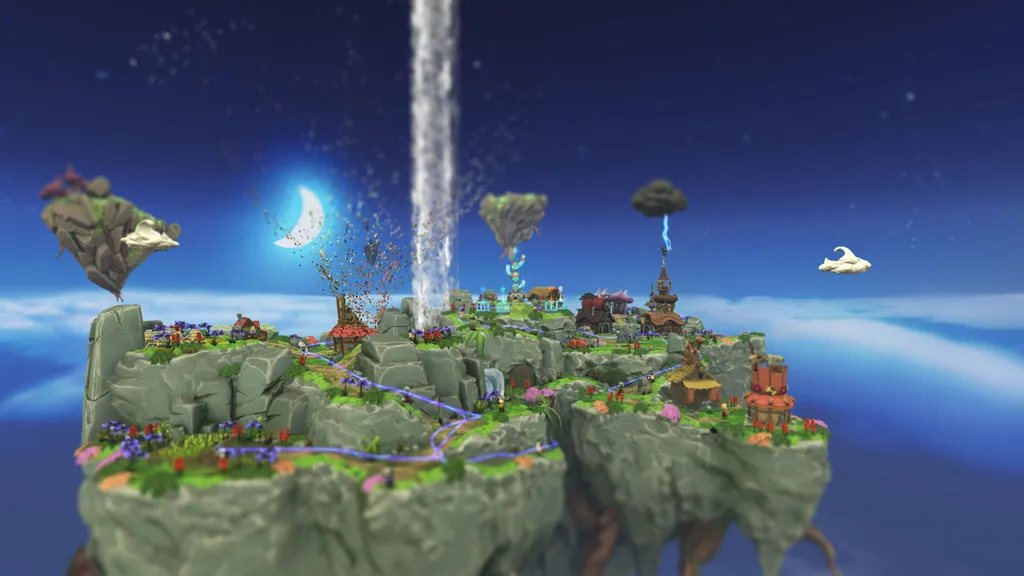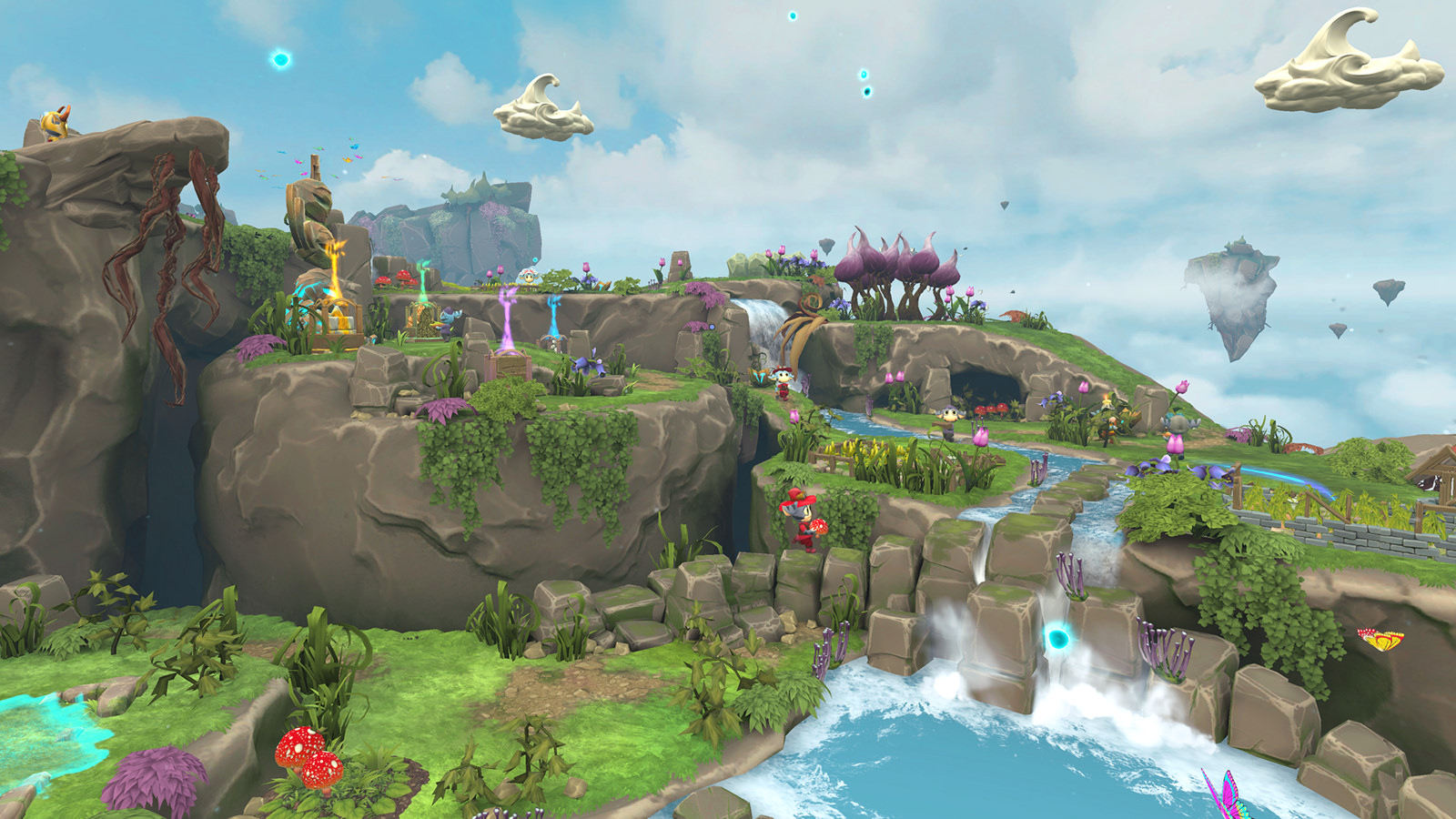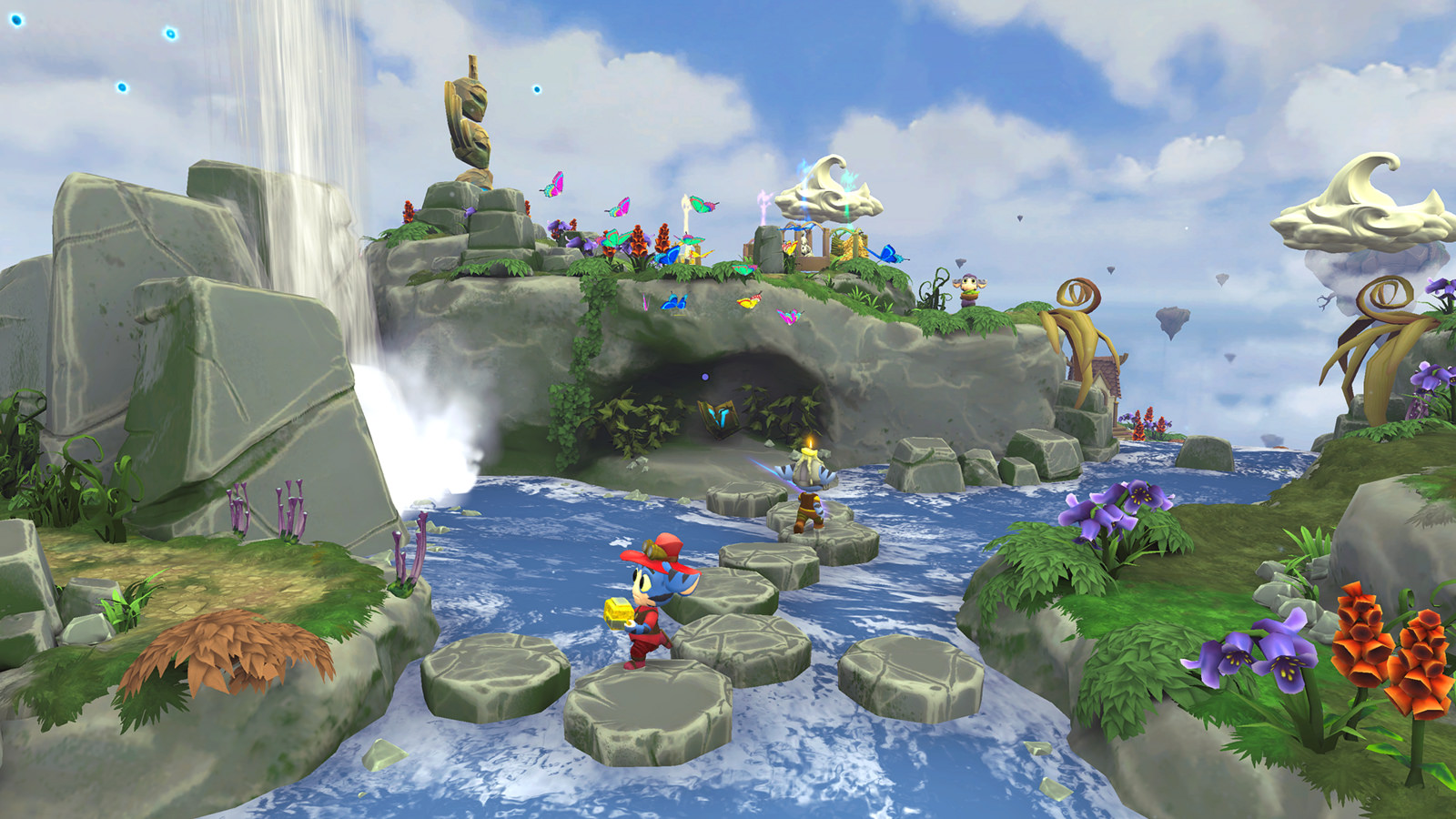How did it take someone this long to make a VR god game? Headsets have only been out a few months, but the thought of taking one of gaming’s most beloved genres and actually making you that omnipotent being is so compelling I’m surprised that Secret Sorcery wasn’t beaten to it. Even more intriguing is that it’s been done first on PlayStation 4 with PlayStation VR, and not the genre’s usual home on PC.
As a first stab at this type of game, Tethered is pretty successful. It translates some staple features like resource gathering, elemental management and prayer systems with great results, but it’s not without its stumbles.
In Tethered, you are a Spirit Guardian, and your subjects are Peeps, adorable little critters, hatched from eggs that drift down from the heavens above. In each of the 13 levels, you’ll need to raise your Spirit Energy to a certain amount by scooping it up as your minions/subjects/believers farm resources, defeat enemies and make prayers. As Peeps work for you, you’ll need to keep them happy by making sure food is well stocked, health is full, and everyone is busy. Ignore the prayers of a Peep for too long and they’ll jump off a cliff. Really, they’ll become depressed and sleep walk over to the nearest rock and step off.
It’s a dark turn for what’s otherwise a bright and breezy game. Staring down into Tethered‘s floating worlds from above is a sheer delight in VR. Leaning in to inspect tiny details like the stalks of wheat that grow in farms or surround yourself in butterflies as they hover below is absolutely lovely. You move around the island by teleporting between a handful of set positions, represented as clouds.
That’s where the game’s first issue rises from. Tethered‘s locomotion is restricted and often frustrating, especially during the nighttime sections of levels in which beasts attack and you’ll quickly have to order Peeps to fight them. This is done by looking at your unit, pressing and holding the X button, and then ‘tethering’ them to the enemy by looking at them and letting go. That’s how you perform all of the game’s actions.
At times, you’ll want a specific Peep for a specific job, but from where you’re looking you won’t be able to select them both. Moving the camera to see them should be as simple as using the analogue sticks to fly through the air, but Tethered doesn’t support this kind of movement. Instead, you have to find a cloud that will give you a better angle, which involves looking away from the targets and gathering your bearings once more.
It’s more than likely the most comfortable option, but the game doesn’t even use the sticks, which is infuriating for people that don’t suffer from sim sickness. Games like Kittypocalypse prove that you can have comfortable free-flying camera movement.
It means that flatter levels in Tethered, where you can see most of the world around you, are decidedly better than the multi-layered areas that are intentionally designed to keep you moving about. The game zig-zags in enjoyment from level-to-level, though the learning curve can also make some of the earlier levels a challenge. Learning and perfecting all of the games’ systems stretches well beyond the already-lengthy tutorial, and you’ll undoubtedly be able to improve scores in previous levels as you get better toward the end of the game.
That’s testament to some pretty excellent design. When you finally master all of Tethered‘s mechanics, including making sure all your Peeps are doing something at all times and regularly using elements to replenish supplies and open up new areas, the game has a great flow to it. It’s a demanding process, especially if you’re going for A ranks across Peep happiness, use of elements and timing, but learning how to juggle it all is a big part of the fun.
Less key to that system are the upgrades. In each level you’ll unlock a set of buildings that can speed up workers, offer more Spirit Energy, create more efficient resource gatherers and more. Each of these buildings can be upgraded, but I never needed more than two or three of them across the entire campaign, and some of their specific functions unnecessarily complicate matters. Upgrading your Peeps is also inessential unless you’re aiming for the best scores. Ultimately, it was a side of the game I largely forgot about as I played.
Still, the amount of micromanaging required here can occasionally become overwhelming, and not in a good way. During the day cycles in Tethered, it’s quite easy to keep Peeps working. During night, however, things become a bit more confusing. As slug-like enemies attack, you’ll need to assign Peeps to go and fight them, and they’ll also fight any they naturally come across. The system doesn’t always work flawlessly; you can send three warriors off to fight a pack of monsters and then look back a few seconds later to find only one of them actually fighting while the others stand by the first one they’ve killed.
Also working against these moments are the head-tracked controls, which lack the finesse required in tight situations. I’d often trying to get one Peep to help another in a fight but accidentally target a small stack of resources sitting next to the battle, and then watch them pick up those resources and leave with their friend in need.
That puts the Peep still fighting at risk of dying needlessly, and in the heat of battle you might neglect some that have already defeated their monsters and are now on the other side of the map. If you leave them for too long they’re going to get depressed, which feels like a needless mechanic. It seems strange to find a Peep kicking around with nothing to do when he could be mining the pile of rocks right next to him. By making you assign every single action and punishing you for not noticing something, Tethered can suddenly leave you with a mess on your hands when you thought everything was okay.
But, in a way, I appreciate that Tethered has these issues, because it demonstrates what Secret Sorcery is really trying to achieve here: a meaty, full videogame. At about seven hours (each level takes between 25 – 45 minutes) it’s lengthier than most VR games, and its mechanics are deeper, no matter how flawed.
Though far from the likes of XCOM, Tethered is a more demanding strategy game than anything we’ve yet seen in VR. Though its islands are smaller and its matches are shorter than something like Black & White, it’s the first VR game to even resemble that type of experience. Tethered is far from perfect, but it also represents something that a lot of hardcore gamers will be pining for after 45 minute Batman experiences; something they can really sink their teeth into. For hardcore VR videogames it is, quite simply, a good start.
Curious about this score? Check out our review guidelines for more information.




























